January 18 - 24, 2015: Issue 198
Robert 'Rob' Berry
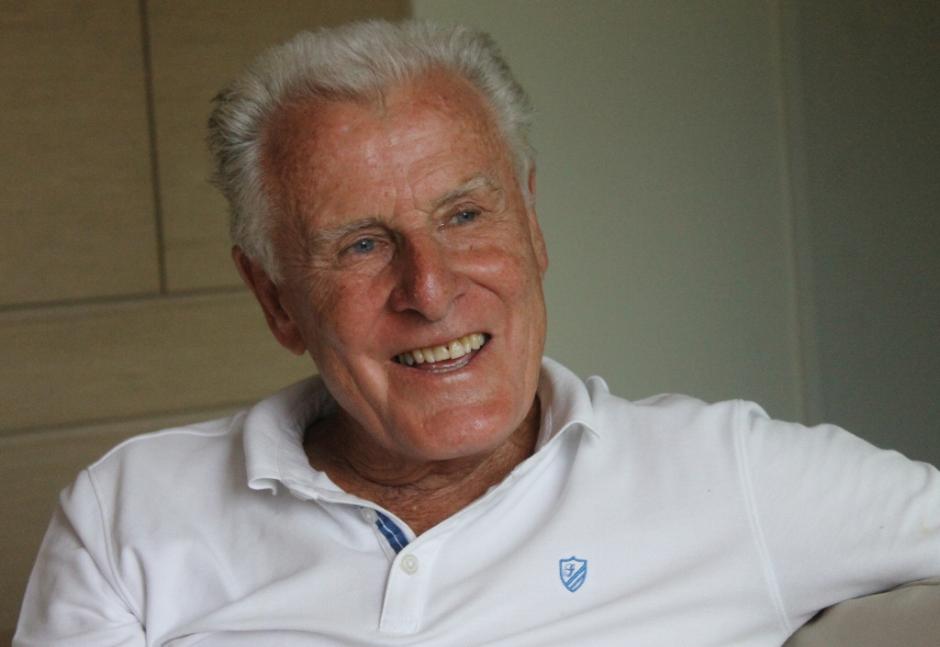
Robert (Rob) Berry
A Life Member at Whale Beach and also at Branch, Rob Berry was President for three years at the club his has given over 50 years service to. Mr. Berry has also had a long and successful career promoting products many of us would remember without realising that his was the mind behind these great ideas - from Adelaide to Sydney to Whaley, this gentleman has brought The Big Swim to another level and given a gift to all our volunteer based surf lifesaving clubs in ensuring it was an idea that became viable for all.
This week we share a small insight into a life lived and being lived still in the large.
When and where were you born?
January 28th 1940 – I’m an Adelaide boy, I grew up and was schooled in Adelaide.
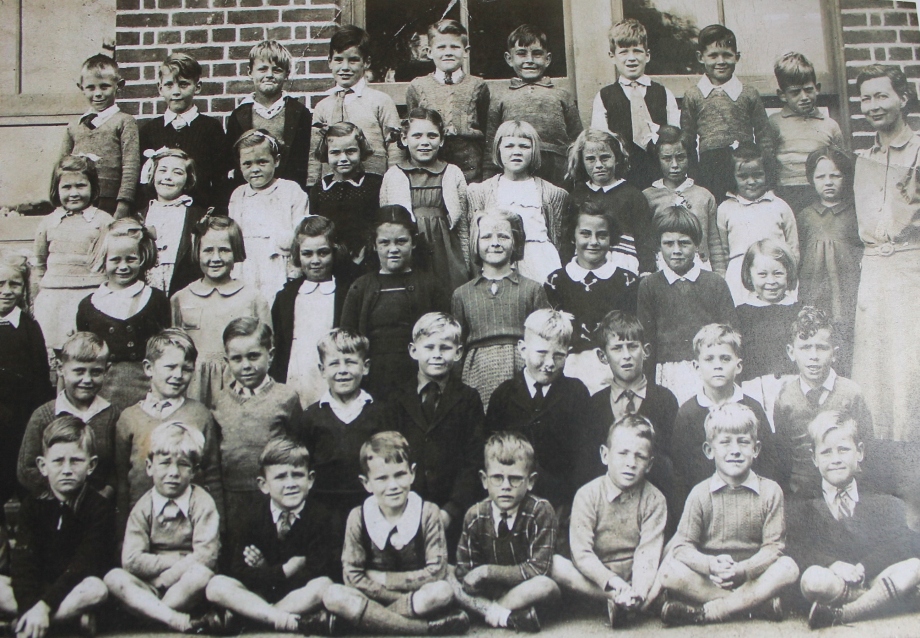
At school, 1944 – Rob is 2nd row, fourth from left
And after school?
My first job was a deck hand on Popeye, the pleasure launch on the Torrens River.
After doing the leaving Certificate at on 16, I actually started off as a Fitting and Turning Apprentice. Family legend has it that some members had worked at Holden’s since it was a saddler’s shop in Grenfell street. My father was involved in designing the Holden car and spent four and a half years in America, in Detroit, Michigan, when I was 18 months old until I was six years old.
A whole team of Aussies went across to put it all together and work out the manufacturing and then came back.
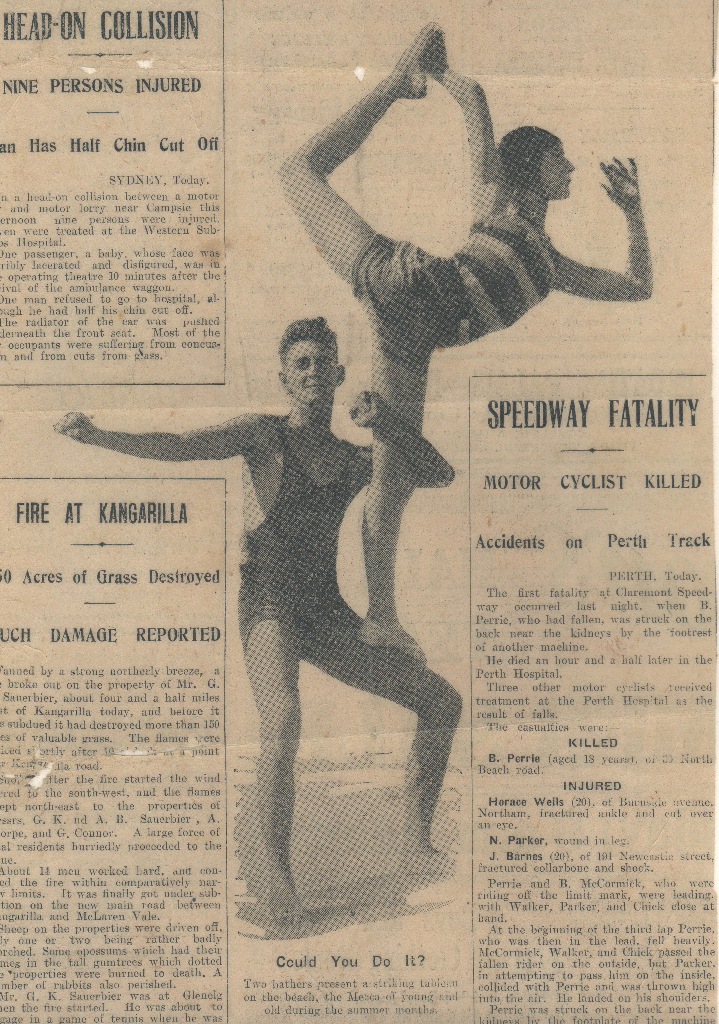
Rob's mum died when he was 18 months old – this photo is of his mum and dad on the front page of the Adelaide News in 1929 – "mum played for State Hockey Team and Physical Culture Team, which is where I got my physical attributes from I think".
I was really not cut out to be a toolmaker or work in factories. I remember people saying ‘if you do your apprenticeship and get a trade then you have a ‘job for life’- which is rubbish of course as they’re all out of work now. Then though, buy the time you were 40 you could get a job in the Drawing Office, as I had a talent for Technical Drawing- but I hated the factory and said ‘I’m out of here’.
My family, of a conservative old fashioned Australian mien, said, ‘well, you’re out of home’ and so at 16 and a half I was out and so I got myself organised and made my own way after that.
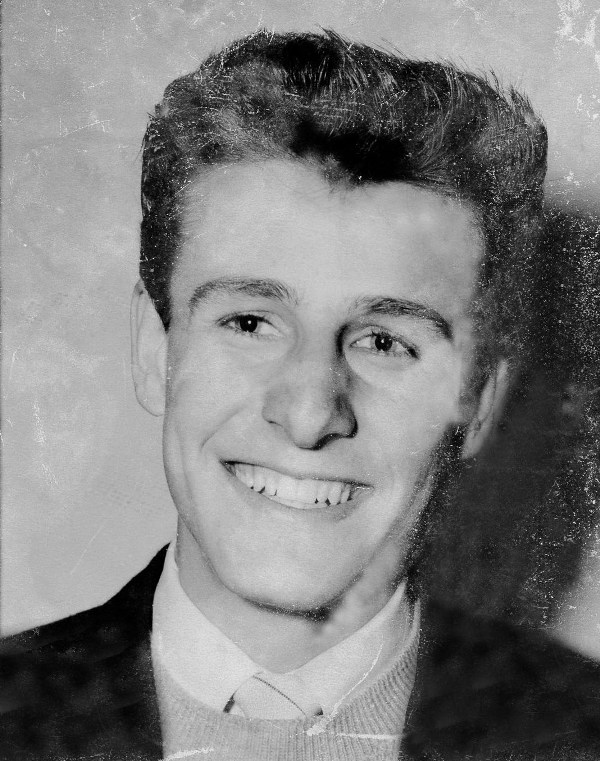
Rob at 17 years of age
I was a Youth Leader in the YMCA and through a Christian contact was employed as a junior Window Dressing and Interior Displays and got into helping design and build the floats for the famous John Martin’s Christmas Pageant.
I joined Grange SLSC when I was 16, when the club was first formed, and in 1956 got my Bronze Medallion. I rowed in surfboats and paddled skis there, was in the R and R Team, March Past, worked on committees.
I was involved in a number of rescues in Adelaide; I remember I took a day off from work when at H G Palmers and went surfing on a pretty rough and wild day, rescued somebody, the ambulance came down and they were taken to hospital – it was on the news that night, and pictures were in the paper – when I turned up for work the next day the boss said ‘so you were sick yesterday were you?’
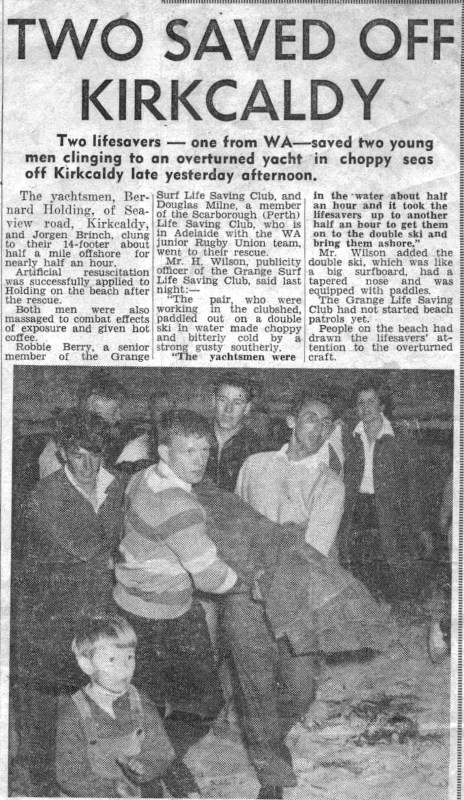
One year, we were also asked to promote the Miss Gidget Competition – and this is the winner of the Adelaide competition:
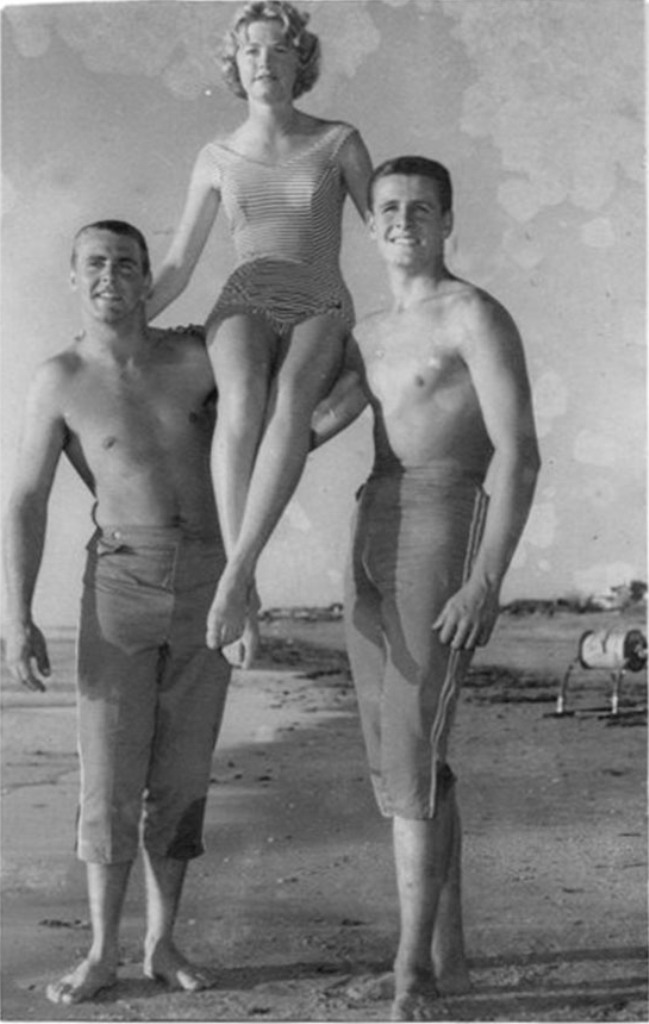
Rob tall chap on right – with Johnny Brown, Heather Baker winner
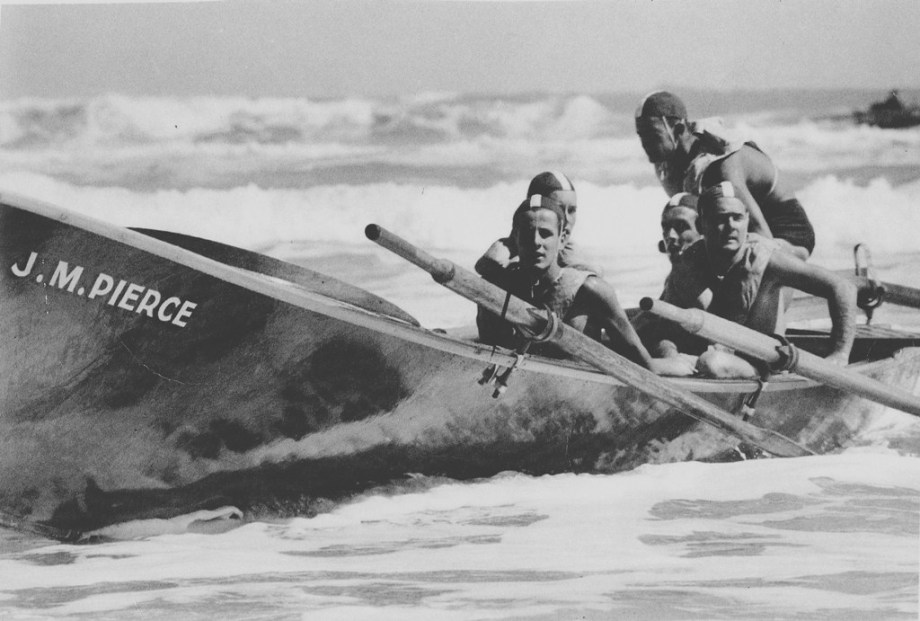
Surfboat photo in Grange – Rob is at front – bowman
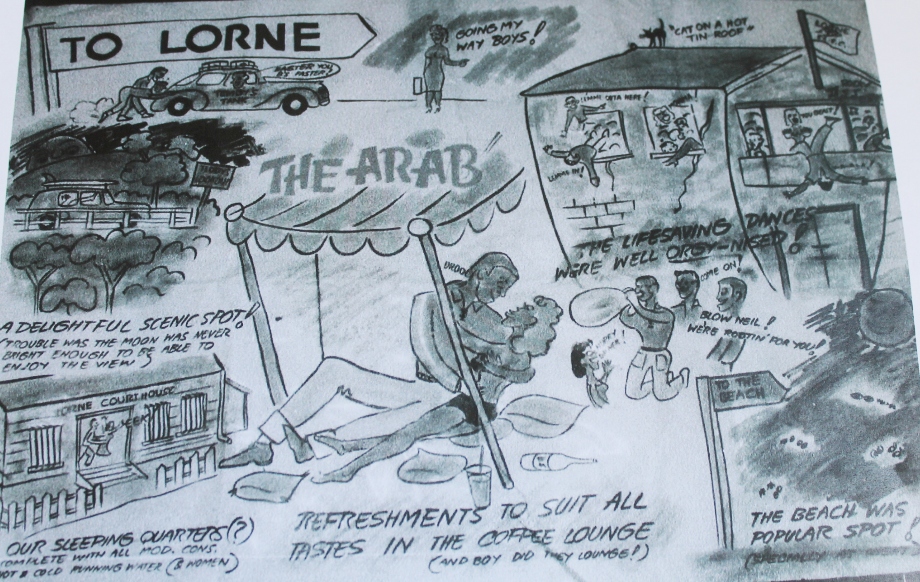
Rob would also do cartoons for the club to promote it
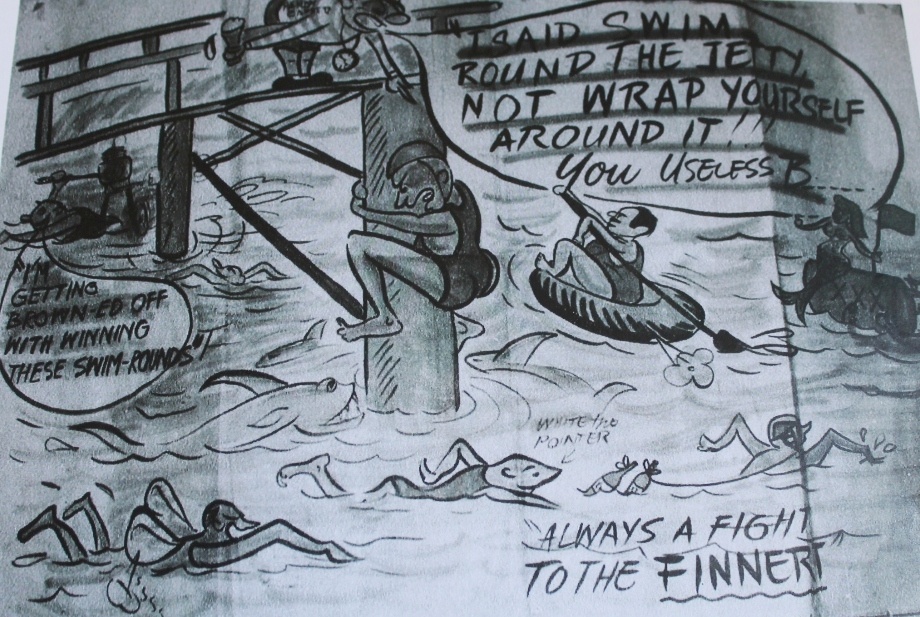
Daily swim was around the big jetty at Grange
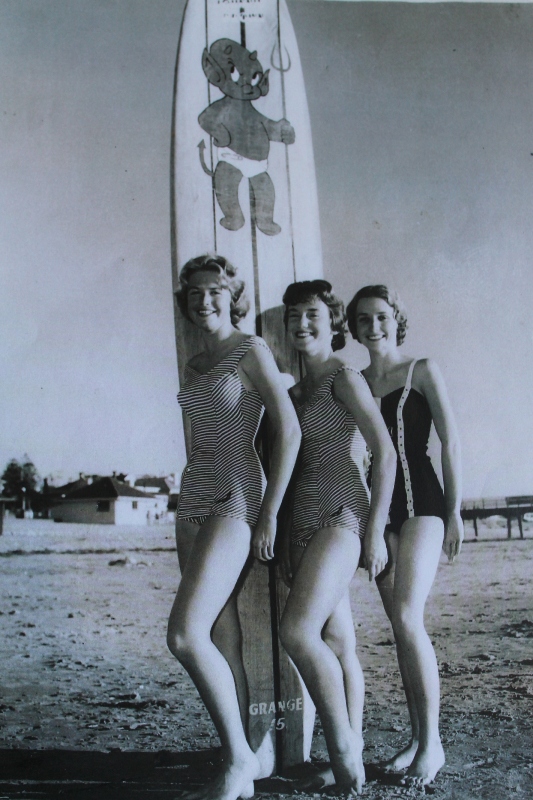
Gidget finalists - Rob’s Bennett surfboard in background – he would paint figures on them
How would you describe the landscape there for those who haven’t been to this part of Australia?
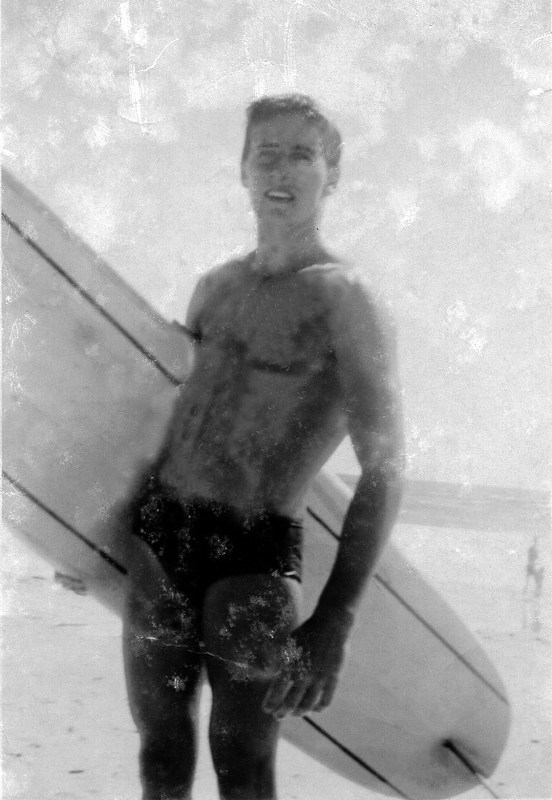 Adelaide has a very very long stretch of wide white sandy beaches, with not a lot of surf on the city beaches. Just around the point there’s a whole run of great beaches where you can get surf, places like Moana, Port Norlunga, Chiton Rocks, Goolwah, Port Elliot, and we used to surf there.
Adelaide has a very very long stretch of wide white sandy beaches, with not a lot of surf on the city beaches. Just around the point there’s a whole run of great beaches where you can get surf, places like Moana, Port Norlunga, Chiton Rocks, Goolwah, Port Elliot, and we used to surf there.
Johnny Brown, Greg Plaisted, Morrie Drent and myself were among the first guys to get Malibu boards in South Australia. They came from Barry Bennett who flew them over.
We used to paddle the longboards before that, which we also bought from Barry Bennett in Sydney and these too were flown over – I remember getting very excited about these boards. We’d go surfing down the coast and there would only be 2 or 3 of us out on a wave.
People would be up on the headland watching and when you came ashore they’d say, ‘what was that – that was amazing’ because they’d never seen this before.
Even when we were growing up, when I was about 16 or 17, there was no television in Adelaide, you had to entertain yourselves, which we did pretty solidly – there’s a few background stories to that which may not be of interest to people other than myself and my friends of the things we did.
What did you get up to?
At one stage a mate and I opened up a little cellar which we called ‘The Sin Bin’. We found a big cellar under a block of apartments to use. We’d go up to the Barossa Valley and get wine and have parties there and show surf stuff, play jazz- like the exotic sounds of Arthur Lyman’s ‘Taboo.
Nothing was allowed to open on a Sunday in Adelaide, you could not go into a pub until you were 21, and all the pubs closed at 6 o’clock.
We were quite naughty in doing stuff like that.
We went across to Victoria many times to Anglesea, Wye River – I surfed Bell’s Beach when you had to go through the Farer’s private property to get tot the beach. I'm still friends with Melbourne girls we met back than, had lunch with several a few weeks back in Melbourne when I was there for a Trade Show.
Adelaide was a fairly conservative tight establishment then – most of my mates when they were 20 or so and their girlfriends 18, whom they’d known since they were 10 years old, became engaged and their family would set them up. I was a bit of a loose cannon wandering around the place, and there was certainly a girl involved, but I said ‘there’s got to be more to life than this, I want out of here, I don’t want to settle down’ – and so I put my two surfboards on my car, and all my worldly possessions and set off into the night and came to Sydney. This was 1961 and I had just turned 21. I put on a 21st birthday party for myself, everyone got very merry or I did particularly, then took off to come over here.
I’d actually lined up a job in Sydney with the H. G Palmers Electrical Stores and the biggest electrical appliance retailers across Australia.
I had already done projects for them in Adelaide helping them open up stores and doing promotions for them. They said they could use me over here and to come to Sydney.
I worked with them for a couple of years opening stores, doing promotions and advertising. I lived out at Bankstown at this stage and found when I went to join a surf club, the first being Bondi, there was all these red brick blocks of units and a funny little strip of shops and concrete everywhere. It didn’t appeal, beaches so uninspiring after the beautiful beaches of South Australia and those I’d seen in Victoria. I looked at other beaches – Wanda, Cronulla – thought about joining and introduced myself but found them really unfriendly; unless you played rugby league or were a local they didn’t seem to want to know about you.
I ended up at Whale Beach one day, surfing The Wedge, there was Johnny Baird and Richie Stewart and Peter Strong out there. They said ‘you’re a new face’ and chatted to me, said come up for a drink at the club afterwards, and the rest is history. I joined Whale Beach SLSC in the 61-62 season and have been at Whale Beach ever since. I got really involved and have been on the committee there for over 50 years. I competed a lot – rowed surfboats, went in the R and R Team, Beach Sprints. My main call to fame would be being the Pillow Fight champion for the Branch time after time. I was only around 12 and a half stone wringing wet and would be matched against 15 stone or more and would lay them off with no problem at all.
My nickname was ‘araldite arse’ because I seemed to stick to the pole.
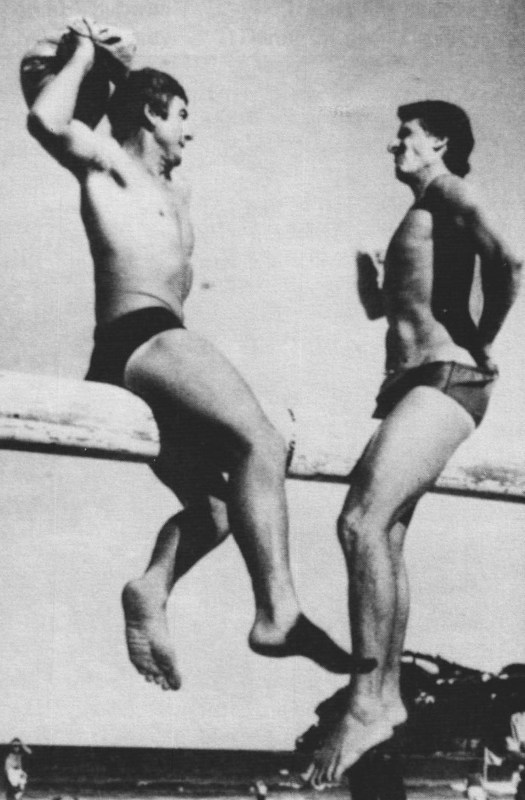
Rob and Bucky from Narrabeen surf club – pillow fight
I led the March Past for Whale Beach for many years – this photo is of me and my son – he was there watching and he ran out and came to attention alongside us while they did the assessment. This is about 1978. I paddled the double ski with Richard Stewart ,we went in lots of carnivals over the years. We never got gold but got a few silvers and a number of bronzes.
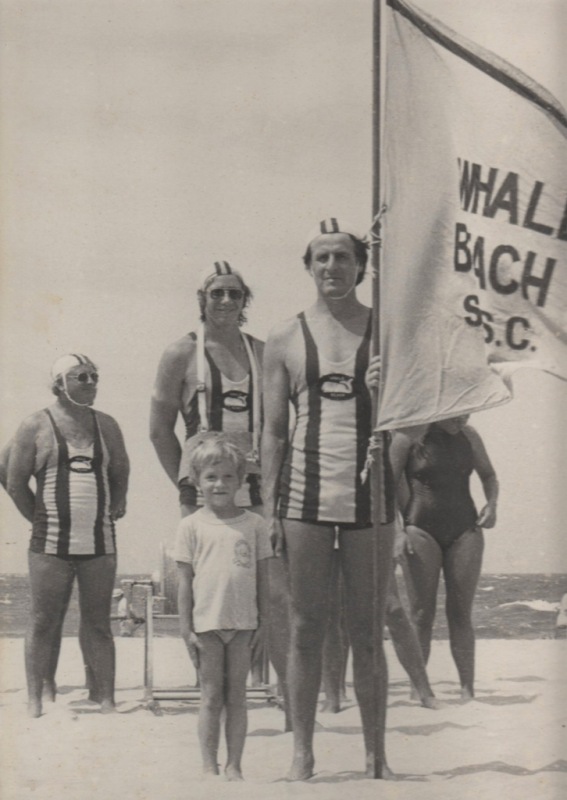
Brad and Rob - March Past!
And you’re still participating in Master’s Competitions?
I have and have done well in the racing ski until recently. Twelve months ago my back collapsed on me and I had to have a spinal fusion so am now just getting back into my paddling. I’m hoping to win the over 75’s if there’s anyone to compete against.
What to you is the best thing about the Master’s Comps?
The challenge to staying fit and also the fantastic camaraderie.
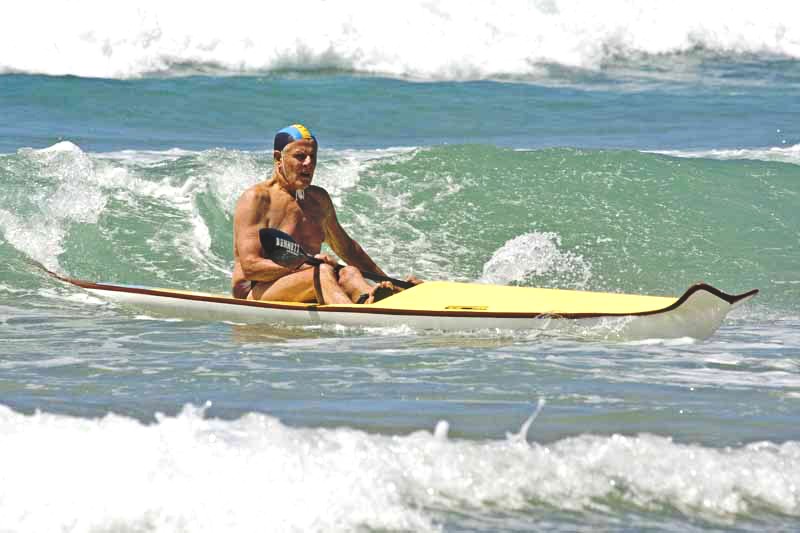
Won Masters at 65 – ski - I last won when was over 70 and only one in that division so was placed in over 60’s and won
What was Whale Beach SLSC like in the 61-62 season?
It was interesting as they owned their own building, which was unique. There was a really good culture in the club with many of the older members being all ex-Army guys. They were all really nice, very straight, encouraging you for your personal best and you were expected to commit to the club and answer your responsibilities.
In those days lifesaving wasn’t big so quite regularly we were doing all day patrols, and this was virtually every other weekend as there was only around 60 active members. Whereas now patrols are only four hours or so.
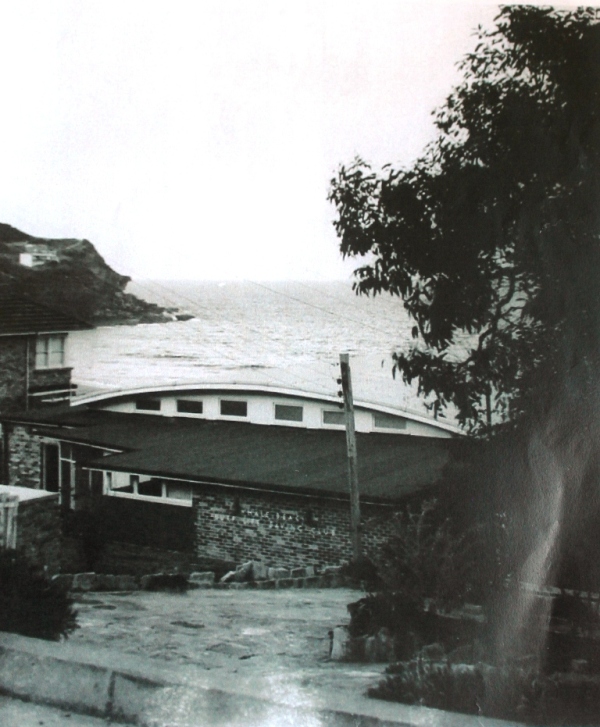
Whale Beach SLSC - 1960
There was a Surfboat named for you Rob, launched in 2007?
The Club had it for 2 years and then it was sold with our crews breaking up. We have another named after Owen Ramsay, a Life Member at Whale Beach – that’s still there. We're keen to get boats going again. I have 5 racing skis down there and could train those interested. We have Bill Phillips, now 70, who used to be an Olympic Water Polo player – who participates in the surf carnivals and has won State medals last season. There are very few staying at the clubhouse nowadays and we want to attract people to use the excellent facilities in the newly renovated clubhouse - it's a great place, beautiful beach.
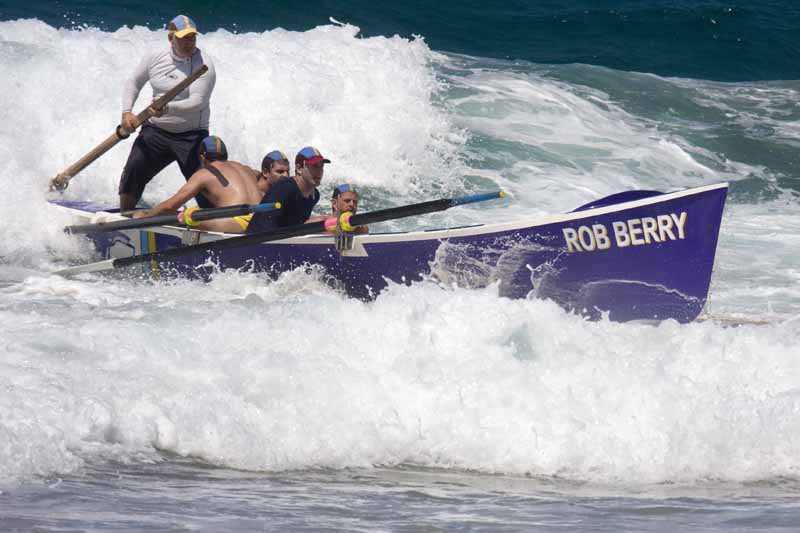
Would you stay at the club for the weekend?
Yes. I had a house at Paddington, the Agency was in Pitt Street, I would come down on Fridays or Saturdays and stay. A group of us also rented a house on Whale Beach road, at 344 I think, facing north. We used to have some good parties there – one was a black tie affair where we entertained USA Navy Officers on leave from Veitnam.
During that period I was part of a group called 'The Regis Committee', which were young executive guys, all in our mid 20’s at that stage.
We decided we wanted to have fun and these could be thought of as the forerunners to Rave parties. We’d send out creative invites, to attend you had to get dressed to go, and hundreds of people came; we’d hire unusual places , a ferry one time for a Roman party, we raised lots of money.
This one for example was a house I found in Coogee which was going to be wrecked. We got permission to have a party in it, people came dressed in evening gowns, we gave them sledge hammers as they arrived – they smashed the place, it caught on fire, the police came – all sorts of events like that. These ran from 1965 until around 1975 – we’d have one or two every year.
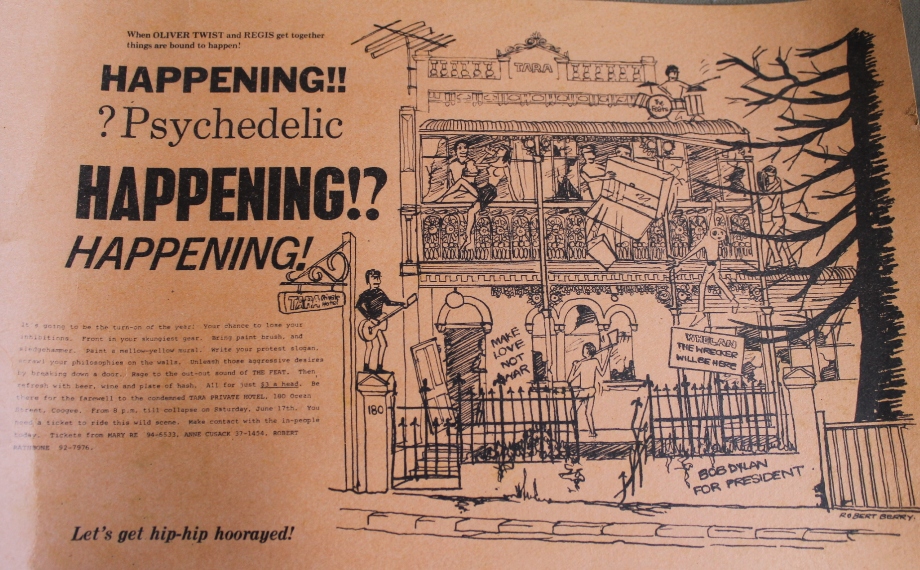
This one was on ANZAC Day – we hired the cellars at The Hero of Waterloo and people had to come dressed in a uniform of the World War. As they came through the door we gave them an official pass, which was everybody sitting on the latrine, they all got a blue light kit in which were a condom, Condy’s crystals, bush biscuits and other necessaries.
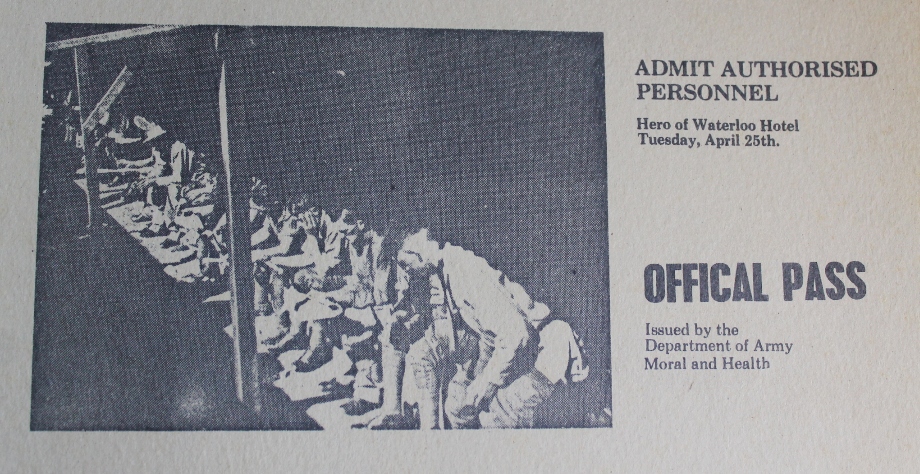
For an Arabian Escapade Night we actually arrived on camels, another was an Oriental Escapades theme, and A Night with Neptune. We we dressed up in Rum Corp uniforms and invited the gentry of Sydney to a soiree – this was a dinner. We arrived in a horse-drawn carriage. Lady in the photo was my girlfriend at that time. They were great parties, we all had a great time.
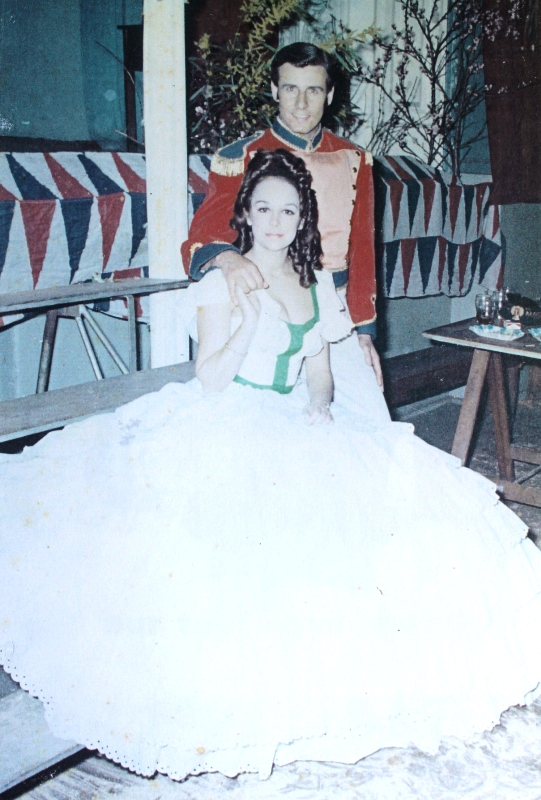
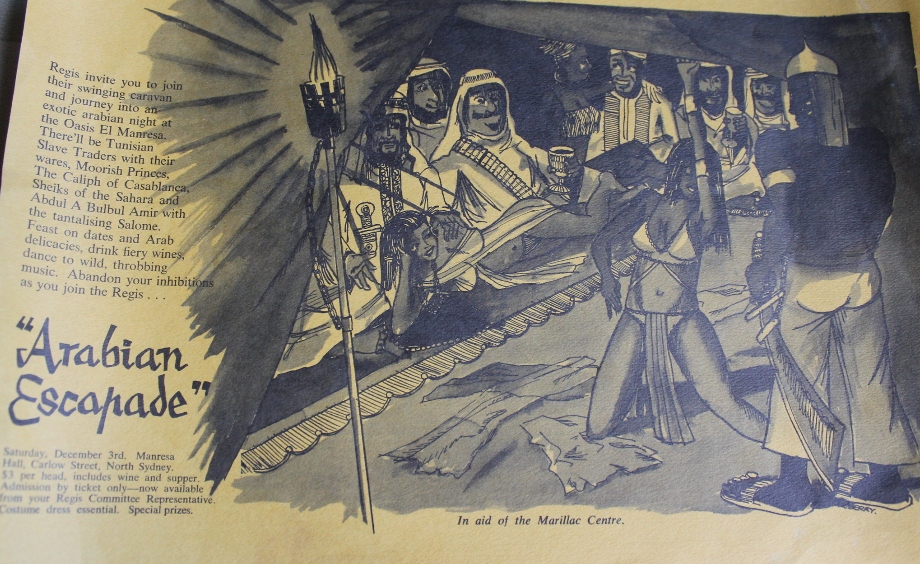
We did them all without getting drugged up or going over the top, without vandalising anything. Most of these parties ended up on television – one of the blokes worked for a TV Channel.
What were you raising the money for – where was it going?
As I remember, someone's sister had a problem so The Marillac Centre for Unmarried Mothers was one of the early ones. There were several overall – muscular dystrophy was one – one of our mates, his brother had muscular dystrophy so we decided to raise money for that research.
What is this one?
That was my Christmas card – Graham Sawyer was a radio announcer on 2UW. He and shared a terrace house for a while, where we also had lots of parties.
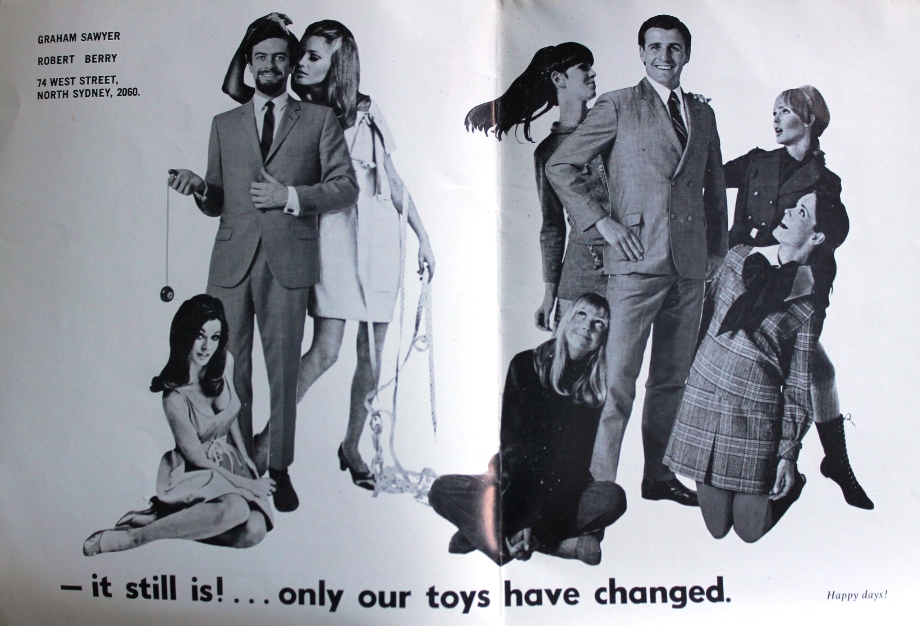
Rob and Graham's Christmas Card
How did you branch into promotions and advertising?
Back in Adelaide while I was working at John Martin’s doing Display I learnt about advertising as display was within the advertising department of the company.
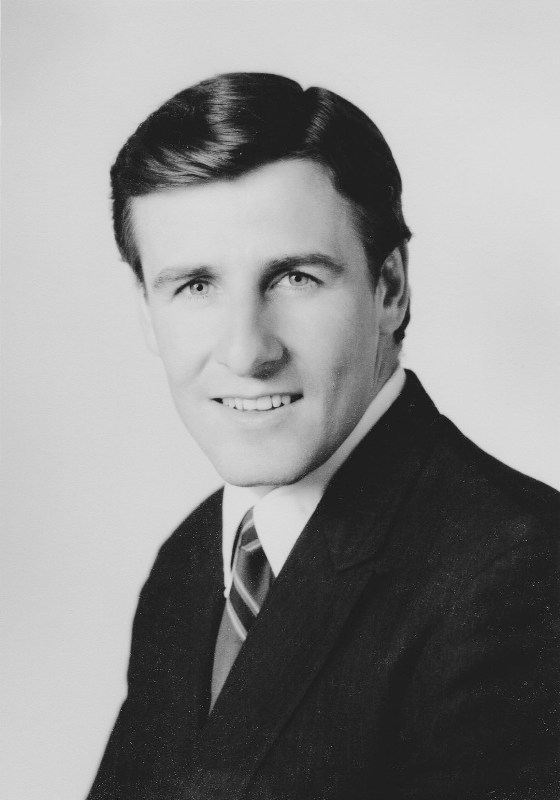 They regularly needed a male model for clothes – so I augmented my income doing this which was fantastic as in those days I was getting £4 .8 shillings a week and was paying £3 for board so it didn’t leave much each week. Doing the modelling work allowed me to learn how ads were put together. I got I guinea a photo used. Often10 guineas in a week.
They regularly needed a male model for clothes – so I augmented my income doing this which was fantastic as in those days I was getting £4 .8 shillings a week and was paying £3 for board so it didn’t leave much each week. Doing the modelling work allowed me to learn how ads were put together. I got I guinea a photo used. Often10 guineas in a week.
Then television came to Adelaide and I was in a couple of TV commercials and saw how all that worked; how they were constructed and put together. At the same time a course started in Adelaide for Marketing and so I went to night school and did a marketing course for a couple of years.
When I came to Sydney they were just starting a marketing course here –– which was at TAFE at Ultimo. There were about 80 of us doing a course called ‘Marketing and Advertising’. It was a three year course that ran three nights a week, including Friday nights which was a drag. In the end only 20 of us finished the course and received a certificate or diploma.
While I was doing that I became a bit fed up with working for H G Palmers out of Bankstown .. I’d often have to be in at the Sydney Morning Herald or The Telegraph at 6 a.m. to look at the proof sheets for the ads for that day’s paper.
Right: Rob at 25 years of age
I met a guy who said he and others were going to set up a company to market sewing machines in Australia – up until then the only sewing machine bought was a Singer and they were only in Singer shops. This was seen as a marketing opportunity and through the Japanese company called ‘Brother’ we found sewing machines. My job was to work out what to do and how to do it; work out a marketing program to get these machines into all the big department stores and fabric shops, which we consequently did very successfully, selling heaps of units of the product along the way. We then introduced knitting machines as well.
I did a whole series of TV commercials through Channel 10 in Sydney and then one with Channel 10 in Adelaide as they had the very latest equipment. Part of this was the very first animated commercial on video, which I created while in the Adelaide studios – where you could actually do a stop/start on video; we had a sewing machine and a little girl jumped up and sat atop the sewing machine and talked to the camera explaining how the machine worked.
The machine was one where you didn’t have to change the foot all the time; it had a universal foot. This meant it would work on everything.
I went on the Del Cartwright Show a number of times and shows like that demonstrating the sewing machine showing all the ladies how they could cut through leather, sew through silk without any problem at all and compereing fashion parades. I would have been about 27 then.
The sales were were successful but I wanted to get out and do other things and work where someone would look after the media. There was a small agency in town at the time called Ridge Anderson who would handle that side and allow me to do other creative things. Through contacts I made I then got the Diamond Traders account – ‘where true love find true value’ – and did that for 15 years or more. They had one store in Park Street and got to sell more rings per week than Angus and Cootes 23 stores – it was fantastic.
We just owned Sydney radio – every radio station that commercials on I had advertisements on – I recall doing commercials with what were then radio stars – people like John Laws, John Mahon. Renee Geyer and many of the up and coming pop singers of that time sang jingles for me. It went really well.
I was also doing advertising for home builders like Petit & and Sevitt – they were just getting going at that time - Ciba Pharmaceuticals– brochures, advertisements, all sorts of stuff.
There was a call one day from 2UE who said they had a guy on the phone who had a stationary product and needs somebody to do some advertising for him and had asked whom they recommend to which they’d stated they thought I was the best in radio – he’d asked for me to give him a call, which I did.
This was two brothers who were general stationary suppliers, such as carbonless paper, the kind of products offices used to use in those days. The brothers had been to a show in New York and got the distribution rights for a new product, Liquid Paper and wanted to advertise it. They had bugger all money, $9000.00 or something close to that – I did some radio commercials for them but explained that they had such potential for this product.
I wrote a Marketing Plan and explained if they did this, went on television, they would own the market, but they were going to have to invest about 80 grand.
They sent the plan to the Liquid Paper Corporation in America. The head of this firm was a man called Walter Berry Bibby, who was a Texan, and came out here and bought the business – he said ‘here’s the money - do it’. I made a 60 second television commercial on Liquid Paper, we put it to air, and it sold and sold and became market leader. Everyone was ‘righting wrongs with Liquid Paper'.
Gillette then went and bought the Liquid Paper Corporation, set up an assembly line in Australia, and at one stage were exporting 28 million bottles – it went all across Asia – I had to go around Asia and set up Sales Offices for them in each country virtually, and do commercials in Thailand, the Philippines, in Malaysia, in different languages – do the packaging design, which, due to my background, meant I could design the packaging , the words and then do the storyboard for the TV commercial and then produce the TV commercial – get a crew together and film it. Liquid Pare sold really well here and in export, well until changes with Government tariffs and it all got too hard with Unions problems. Gillette close the Aussi plant down and put it into Thailand and it was all produced there – so that work went.
Gillette at that time had Papermate, Waterman and Parker products – so I had all those to promote too.
Liquid Paper was only one catergory, we needed something else. I did some research and found Australians used something like 110 million wood case pencils every year. I remember my father coming back from America with a propelling pencil called an ‘Eversharp’. It was a beautiful spherical looking thing of steel which you turned and a lead would come out.
That seemed to me to be a possible answer – I thought there had to be a way to make this so the kids would like them and we could sell lots of them. Gillette said ‘go where you think you may find them’ – I went to Japan with Ian Abbotte, one of the original brothers now employed by Gillette. Found a company called Kotobuki . They had just developed a special clicking system and we developed a casing design and so the Pacer pencil came to be. The commercials I did emphasised how you could write a whole page with just one click.
Gillette said they couldn’t see it taking off and let us make 10000 – we sold these within the first month. Then we had to air freight more out and in the first year we sold 3 million. Sales continued at a great pace, as we introduced new colours, and a new commercial with that little chap who used to jump around.
While I was doing that, Gillette got me to do the packaging design for their blade refills as well.
For Papermate I was doing their catalogues every year for Back to School and new product promotions.– I was a pretty busy boy.
While all that was happening 2UE again phone me and said they had a guy on the phone called Bill Brewin who with a partner has a small manufacturing company that makes mattresses. They were called ‘Lotus Land Bedding’ and wanted to do some advertising. I talked to these guys and looked at what they had, did some research and found that most beds here were 40 years old – people never changed their mattresses, the sale of beds in Australia was tiny.
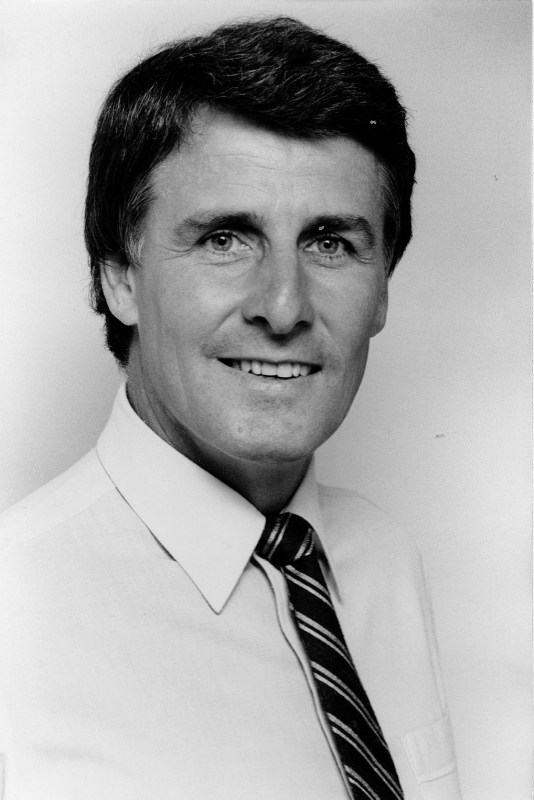 We put together a PR campaign about how important good sleep is, including the health aspects of this. We then looked at how mattresses were built- if there was something inbuilt we could do that world create a unique selling proposition.
We put together a PR campaign about how important good sleep is, including the health aspects of this. We then looked at how mattresses were built- if there was something inbuilt we could do that world create a unique selling proposition.
In England a system was just developed where instead of individual springs in a cloth pocket, or were just crimped together, this one had been developed using a special machine that actually knitted the wire together – all the wire was interconnected and worked with each other. We talked to the company in England, said ‘let’s do this together’ and launched Slumberland Beds in Australia.
We then knew we had to market these in a special way so the retailers will understand and so put on big Trade Nights at the Wentworth Hotel, another in Brisbane, the Southern Cross in Melbourne – we’d invite 200 retailers or more and their wives along and I’d do the stage presentation showing them the commercial – always keeping it funny, sending it all up – and it went over the top. Over a number of years.I did those advertisements with the steamrollers, with Howard Craven, a popular radio personality as the announcer
We had a three month waiting list so needed more people in production. Advertising for workers,I put Howard Craven on television saying, ‘if you invent a better mouse trap people will beat a path to your door’ –again the sales got out to six months. We ended up getting two Bristol freighters to fly steel out from England because we couldn’t get enough out of BHP – what a PR coup that was, it was fantastic. I put an advertisement in quite a few papers which stated ‘The Year’s Best Job –Chief Tester in a Mattress Factory’ – we needed some quality control guys. Slumberland was the market leader by far. I was around 35 to 40 at this time.
The men who had started it were getting a bit ancient. A few years later, they got a buy-out through Pacific Dunlop and sold it off. Pacific Dunlop stuffed it all – they didn’t want to pay the licences or something. Slumberland now doesn’t exist at that same level anymore and they’ve let the American Sealy company take over the market here.
Exactly the same thing happened to Diamond Traders – Jack Allison got to around 70 years of age, decided to retire, and Hookers, who own Prouds and had a big share of Angus and Coote, decided to buy it. They said ‘we don’t need your advertising, we’ll do it’ and Diamond Traders no loner exists.
When the Gillette account was occurring I’d left Ridge Anderson and got a job with a company called ‘Holt and Associates’, who were specialists in Industrial Advertising but wanted to broaden and have a small consumer group. When I went there I had Liquid Paper Gillette Stationery accounts and some home building accounts.
One of HOLT clients was Boral and so I did various advertisements and catalogues for Boral for many years. A few years on several of the Boral people went to CSR who then got in contact with me and I was doing the advertisements for Monier roof tiles – ‘the top cat in roof tiles’
Another of the Boral men became the Marketing Director at Taubmans, which also owned all the Bristol Paint stores, who again then got in touch with me to ask if I’d help them with their advertising. At that stage I was 58 and BBDO – Barton, Burston, Durst0n and Osborne had bought out Holt with Clemminger Advtg . They wanted to move everybody into Clemminger up at St Leonards. We had a few to and fros and they agreed they I set up independently at Crows Nest, which was what I did. They had so much space when my lease ran out at Crows Nest tit wast insisted I move to St Leonards, which I did for a short time. Around then an new young MD came out and ‘restructured’, with over 50’s redundant because ‘you’re no longer creative – this needs to be a young agency’ …rhubarb, rhubarb, rhubarb…
I said ok, I’m out – but the silly buggers didn’t tell any of my clients, who subsequently told them to get stuffed and asked me to take over their work, which I did for a number of years, working from home, winning the Best Design for a Trade Show in Melbourne, another for the Best Stand in Sydney. They were then bought out by the Pittsburgh Pipe and Clay Group who got rid of many of the Aussie executives and moved the office to Melbourne – so that work went.
Gillette’s big office in Sydney moved to Singapore around the same time, and then they got bought out by Proctor and Gamble – so all their products went there and their office was set up in Melbourne. They asked me to go there, which I did, but the office was filled with young girls who treated you like you didn’t know what you were doing, bossed you around and when asked about campaigns would say they’re no good and then six months later, after I’d left, there was my recommended campaign all over Australia.
Kiddiesafe, all those fun and water safety flotation devices for young children– I did those TV ads for years. Kiddiesafe was then brought out by Hasbro, which was another American company. Again the packaging was changed and they lost the proven name and all associated with it; the guarantees, the distribution - after paying a lot of money for it.
What in your experience is the difference between a successful advertising campaign and one which makes the product disappear from the market?
A product usually disappears from the market when new people come in and think they can do it better. If it’s not broke, don’t fix it.
And a successful one?
The product has to deliver on its promise, that’s the main thing. Like the Kiddiesafe product – like the Slumberland bed – the demonstration illustrated it really well; people couldn’t believe you could get a steamroller to run over a bed and you didn’t move. I remember doing a commercial down at Warringah Mal – people couldn’t believe it worked. I recall another where we had two logs of wood on the bed – the alarm goes off and one wakes up and the lady log says to the male log ‘how did you sleep?’ – answer ‘like a person’. Simple little ones work – We did another like a three bears show. I’d always put humour into things and build a product personality – it has worked.
What do you think of those running nowadays where someone is bellowing at you?
 I turn them off – supposedly they work for advertisers but… I find that hard to believe.
I turn them off – supposedly they work for advertisers but… I find that hard to believe.
Mine were always nice and friendly, good in tone – or fun in the demonstrations – Mr Pacer racing across a landscape on his pencil-skateboard – all different versions were fun and were considered innovative at the time.
Nowadays I’m working on something new. The people who acquired Pacer pencils came back and said there was another opportunity for something alike these in the craft market. This involved developing a special lead that is ceramic; you can draw on fabrics with it and rub it out with an ordinary eraser or just dib it off with water. I do the packaging for them and it has been here in Australia for seven years and is the market leader.
Website: sewline.com.au
My theme was always ‘work hard, write hot and tell the world what you’ve got’ and this became my creed in a way – to communicate to people if they have a problem with something here’s a product that can help them and how it can.- not just how to out- pose someonelse with something more expensive.
My daughter, who has marketing experience, and retail experience through working with her mother, set up Sewline Products as a subsidiary of Berrygood Marketing and last year were awarded the Craft Product Supplier of the Year by The Craft Association.
At present we’re working on new technology, scissors which can be used in either hand. They’re made in a place called ‘Seki’ which was where the original Samurai swords were made. I’m doing the packaging and words for these, and this has to be done in six different languages.
So you haven’t retired?
No. why would you? My involvement is very stimulating, a continued challenge and I can only do so much surfing or lazing on the beach.
The Big Swim – running for its 41st time this year – what do you do there?
I’ve been involved with The Big Swim since 1974, when Bob Lynch was the Captain at Whale Beach SLSC. I was in the first swim and many of those afterwards for many years. My good buddy Richard Stewart and I have been the main organisers.
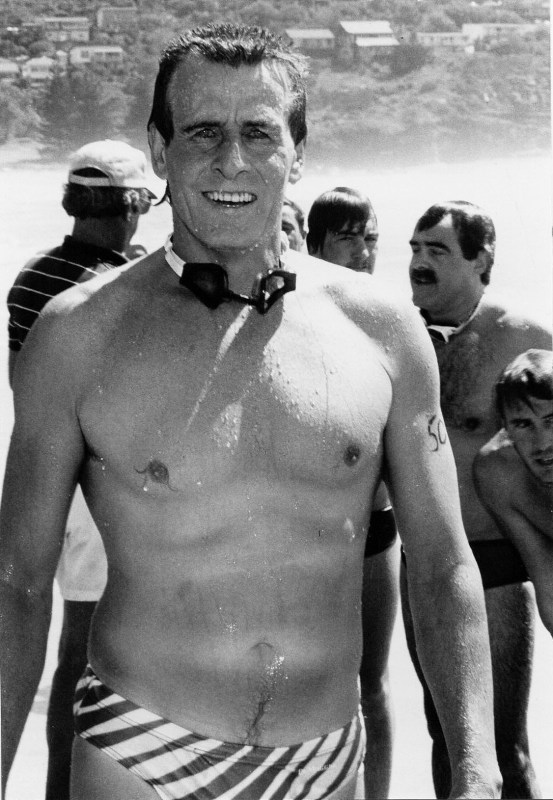 As it got bigger and more and more people wanted to do the swim, tI came up with the idea of calling it The Big Swim – started promoting it, doing the logo, and the rest is history; we’ve had 38 thousand people go in it over the years, raised over a million dollars for Whale Beach Surf Club.
As it got bigger and more and more people wanted to do the swim, tI came up with the idea of calling it The Big Swim – started promoting it, doing the logo, and the rest is history; we’ve had 38 thousand people go in it over the years, raised over a million dollars for Whale Beach Surf Club.
Right: Rob finishing 1986 Big Swim
What was Bob Lynch like?
He was a lovely guy, a police sergeant who unfortunately died in an accident while on his motorbike. His son Barton, the surfing champion, has swum a few times in The Big Swim. It was Bob’s idea to challenge our guys in the surf club, and there were a few non-members in that first swim. We were all a bit toey about sharks in those days as there used to be a few Noahs around from time to time. We put skindivers at the headland during that first year, asked them to swim around.
During those first few swims I built stalls alike those used for horses and people had to run through these and get their time at the end – then it would take upwards of two hours to work out who had won at the end. We then came up with electronic timing and introduced that to all the Ocean Swims – with most of the clubs following us both on the south side and the north side.
In 2008, which was The Year of the Lifesaver – 100 years of surf lifesaving, we were awarded The Event of the Year.
Over the 40 years Richard and I have shared the responsibility of the The Big Swim. We’ve decided we need to get some more help and managed to find a local guy, Simon Morgan. He’s doing a great job pulling it all together – making sure the Water Safety is right, helping organising Marshalls along with Dr Bob Wines and his wife .This year we’ve upgraded the website – I’ve done videos – we’ve had a guy up in a helicopter filming and Mike Munro has done the voiceover for us.
How many grandchildren do you have?
My daughter has two little girls and my son Brad has two boys and a girl – gorgeous children.
The Grey Whales Patrol – are you still part of Patrol Number 1 at Whale Beach?
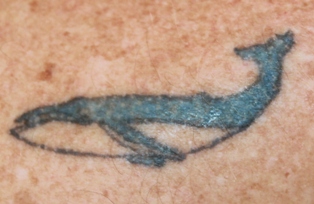 I was until they put the bolts in my back. A story there; I said to the guys we’d been doing this patrol for a number of years, had known each other for 30 or 40 years, I reckon we should all get a tattoo of the logo I designed for the club, which they changed from the reel as we weren’t using those anymore. Those in the Grey Whale patrol said, yes, great idea – can you get one and we’ll have a look at it and then we’ll all do it’. So I did, on my 63rd birthday, when I was in Gertrude Street in Melbourne. I came back, showed the guys and then….’my Doctor says I’ll get AIDs for sure’ …’my wife thinks that would be stupid’.. etc. –one other guy got at tiny tattoo – that was it..
I was until they put the bolts in my back. A story there; I said to the guys we’d been doing this patrol for a number of years, had known each other for 30 or 40 years, I reckon we should all get a tattoo of the logo I designed for the club, which they changed from the reel as we weren’t using those anymore. Those in the Grey Whale patrol said, yes, great idea – can you get one and we’ll have a look at it and then we’ll all do it’. So I did, on my 63rd birthday, when I was in Gertrude Street in Melbourne. I came back, showed the guys and then….’my Doctor says I’ll get AIDs for sure’ …’my wife thinks that would be stupid’.. etc. –one other guy got at tiny tattoo – that was it..
What is your favourite place in Pittwater and why?
I rather like Mackay Reserve. During the years I’ve had lots of overseas visitors who don’t know this area. I’ve taken them up to Mackay Reserve – Swedes, Americans and Japanese people. Often I invite them here, to our home, for a meal rather than take to a restaurant as it’s so much nicer to have them home and we have this spectacular view over Careel Bay.
I’ve also taken people to the Bible Garden at Palm Beach – a few days ago I had a couple in their late 30’s who’d come from Ashford and were at Palm Beach for the very first time. They loved it. Those two spots for overseas people are great – they get a feel of what Pittwater is about. I’ve taken people to Clareville too – shown them how beautiful it is there as well.
My favourite spot is here – home. What more could you ask for really – there’s nothing in front of us but Careel Bay – I go down most mornings and have a swim or a paddle – come back here and do a bit of work or, if there’s a tide on and a bit of a wave I’ll go down to Whaley or Palmy of an afternoon. So home is the favourite spot, easily.
What is your motto for life or a favourite phrase you try to live by?
It would be like that song – ‘Don’t Worry, Be Happy’.
I try to build humour and fun into most things I do – be it with my kids, my work – being creative, having fun with whatever you’re doing – trying to get as much joy as you can out every moment that’s there.
I’ve been an asthmatic all my life and that made me face a disability, decide to get over it and do whatever I can do, all the time – to get over it and get on with it.
I’ve kept going; training and rowing and swimming, which in turn has got me to 75 years old in reasonable shape.
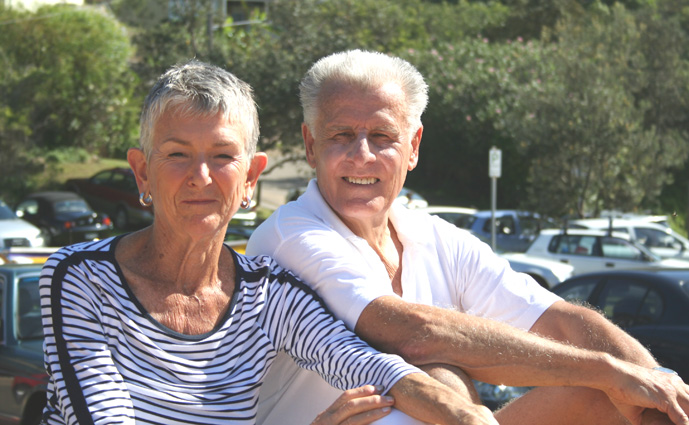
My wife Jill – she did all my artwork for years – we met while she was working for a client
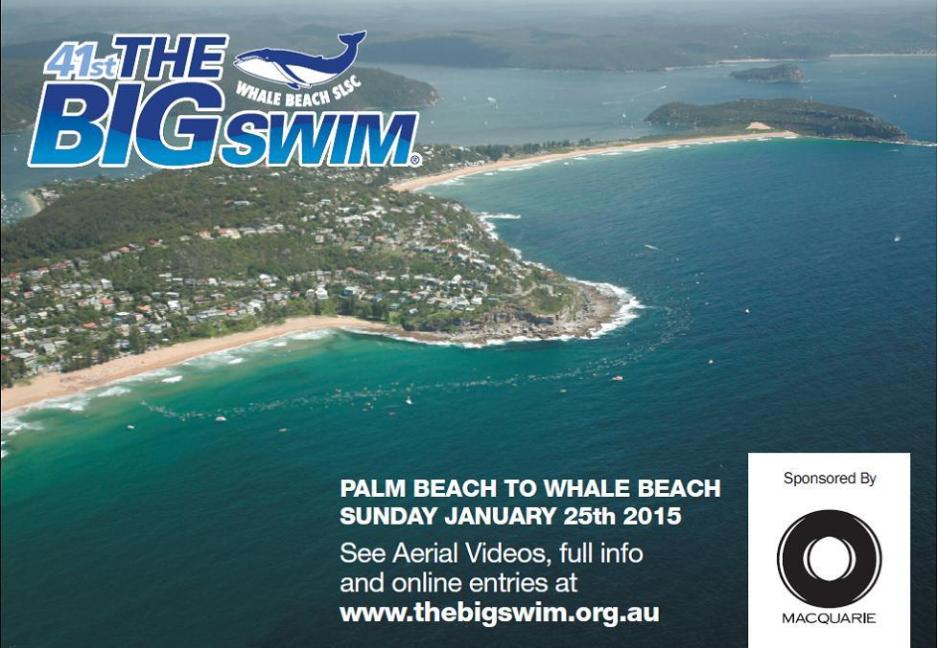
Extras:
Adelaide's Christmas Pageant was founded by Sir Edward Hayward, owner of the Adelaide department store John Martin's, who was inspired by the Toronto Santa Claus Parade and Macy's Thanksgiving Day Parade. He opened the first 'Children's Christmas Parade' on 18 November 1933 at the height of the Great Depression. It was a success; running for around 40 minutes with just 8 floats and 3 bands, it attracted 200,000 spectators and from then the tradition of the John Martin's Christmas Pageant or as it was affectionately known the 'Johnnie's Christmas Pageant' was born. Father Christmas was introduced in 1934 and tradition of the pageant finishing at the Magic Cave (itself created in 1905) was established.
During the war years of 1941-1944, the pageant was in abeyance. It was restored in 1945. By 1969, the event had grown significantly, with attendances reaching 500,000 and television broadcasting commencing. In 1979, the largest induction of new floats took place, with 16 joining the pageant.
In 1985, John Martin's was acquired by David Jones Limited, who continued the pageant under the John Martin's name. However, with the collapse of the Adelaide Steamship Group (of which David Jones was a significant member), and the public float of the David Jones retailing arm, in the mid-1990s the South Australian Government acquired the event. It sought sponsorship from the South Australian business community, and in 1996 sold the naming rights to the six South Australian Credit Unions: Australian Central, Savings & Loans,Community CPS, PowerState, Satisfac and the Police Credit Union. Today, the pageant is managed by Events South Australia,[11] a division of the South Australian Tourism Commission. Adelaide Christmas Pageant. (2014, December 24). In Wikipedia, The Free Encyclopedia. Retrieved from http://en.wikipedia.org/w/index.php?title=Adelaide_Christmas_Pageant&oldid=639408247
Saddlers' shop became a national industry
In Adelaide 60 years ago there was an efficient and enterprising saddler named Henry Holden, who, in partnership with a man named Frost, went into business as a coachbuilder.
OUTSIDE his premises in Grenfell street he set up a life-size white horse that became an Adelaide landmark. The business prospered and, by the time his son, Edward, came into it in 1907 there were 120 workers. From coach building the firmturned, with the years, to building motor bodies; first one or two at a time, and then in large numbers. Young Edward,who had been to the university*no [got a degree in science, wasproving, also, a man of business.The motor body building soongrew too big for the saddlers'?hop.In 1917 a new company, Holden Motor Body Builders Ltd.,was formed.
Production jump
A factory was taken over to King William street— on the site where Myer's bulk store now stands. By the end of the year two open tourer bodies had been produced.From then on productionfigures spiralled.In 1923 more than 12,000 bodies were turned out— and a start was made on the Woodville plant..Finally the firm was turning them out on mass-production belts at the great plant, which now covers 55 acres.It was then that Edward Holden took a trip overseas, and talked General Motors executives into an agreement to turnout all their Australian requirements.This was in 1923, and a few years later came the big depression. It took all the ingenuity of Edward Holden to keep the great plant working.He did it by making fruit cases, golf heads, and filing cabinets.Thus, when better days came, Holden's of Woodville was intact, and there - came the merger that resulted in one of Australia's greatest industrial enterprises— General Motors Holdens.When war came the firm was equipped for a major part in Australia's war production.When Sir Edward Holden died last year, nearly 10,000 people were working for his firm. A third generation took over, and nephew Mr. J. R. Holden is now chief executive of the Woodville plant.This week General Motors Holdens announced the new Australian car it has developed would take the name of Holden as a tribute to the family who built a business from humble beginnings to the mammoth concern it now is. Saddlers' shop became a national industry. (1948, September 4). The Mail (Adelaide, SA : 1912 - 1954), p. 23. Retrieved from http://nla.gov.au/nla.news-article55898888
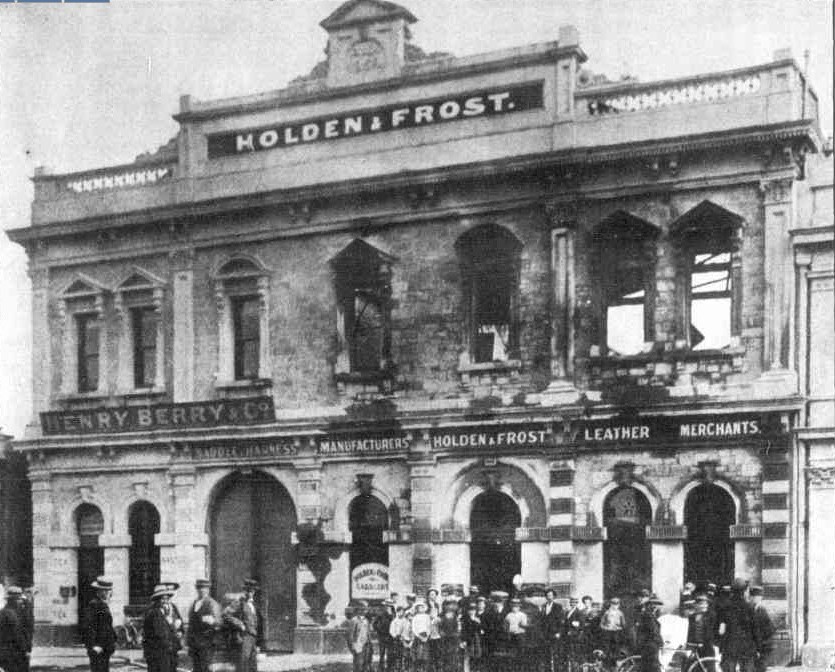
MESSRS. HOLDEN & FROST'S SADDLERY ESTABLISHMENT IX GRENFELL-STREET. PARTIALLY DESTROYED BY FIRE ON TUESDAY EVENING, FEBRUARY 10.
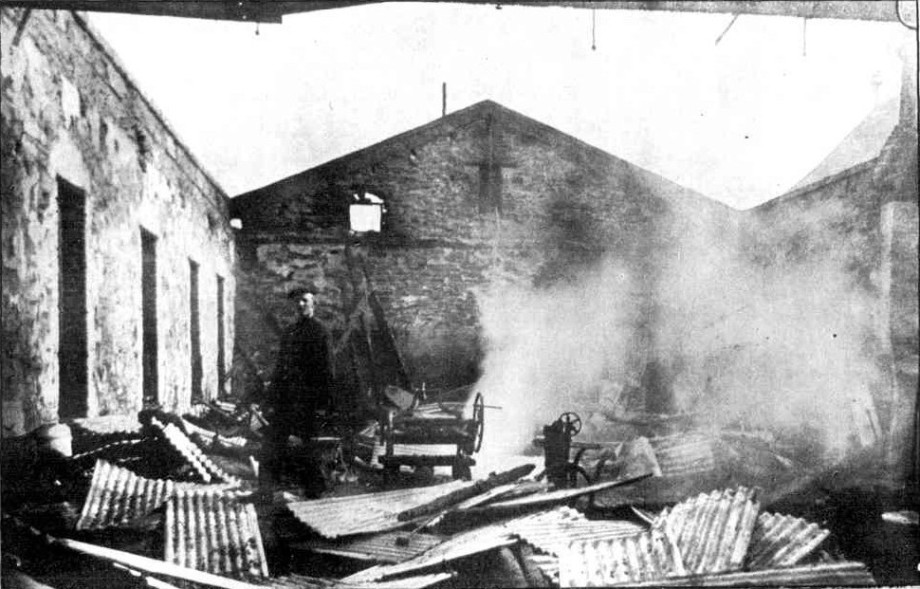
THE FIRE AT MESSRS. HOLDEN & FROST'S: AN INTERIOR VIEW.
DRINK LEGISLATION. (1903, February 14). Chronicle(Adelaide, SA : 1895 - 1954), p. 44. Retrieved from http://nla.gov.au/nla.news-article87840172
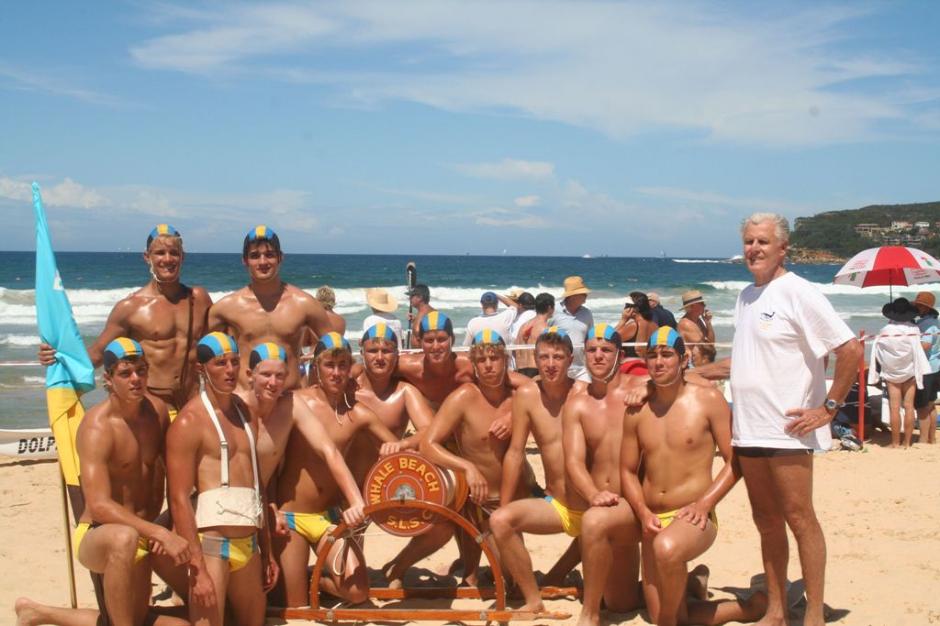
Rob Coached the Whale Beach Males and Ladies March Past Team, both winning the medal at the Branch Championships.
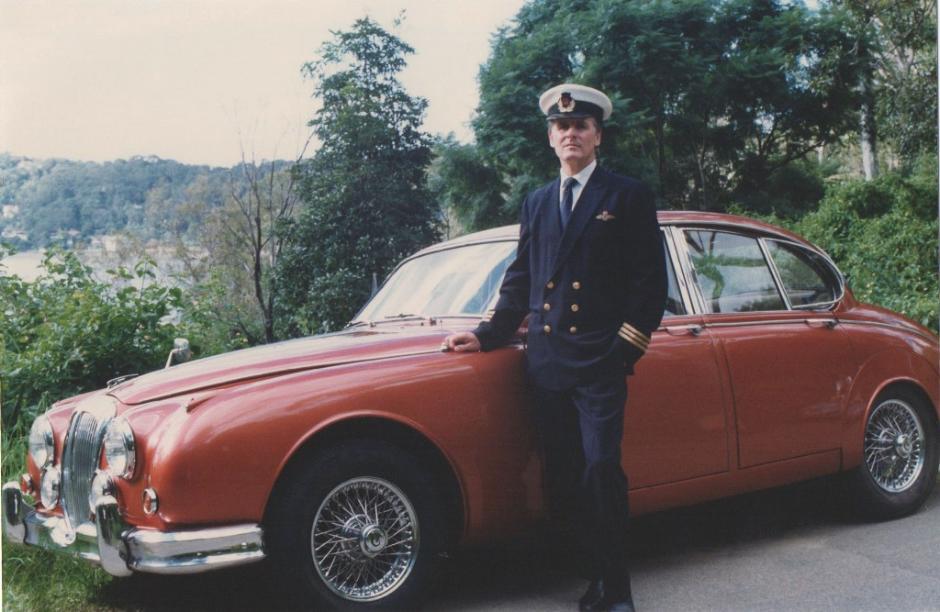
Above: Car Daimler – ‘toy’ – ANZAC Day party at Palm Beach – had car for 16 years – year model 1965 – copper bronze in colour, cream inside, wire wheels. Loved it.
Below: Sports Car in Sydney at 22 years
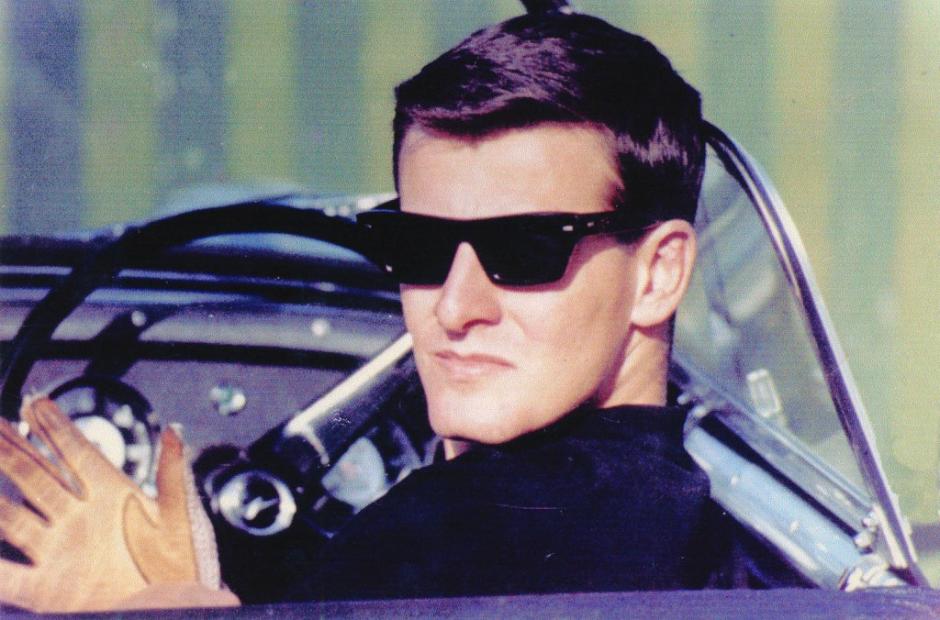
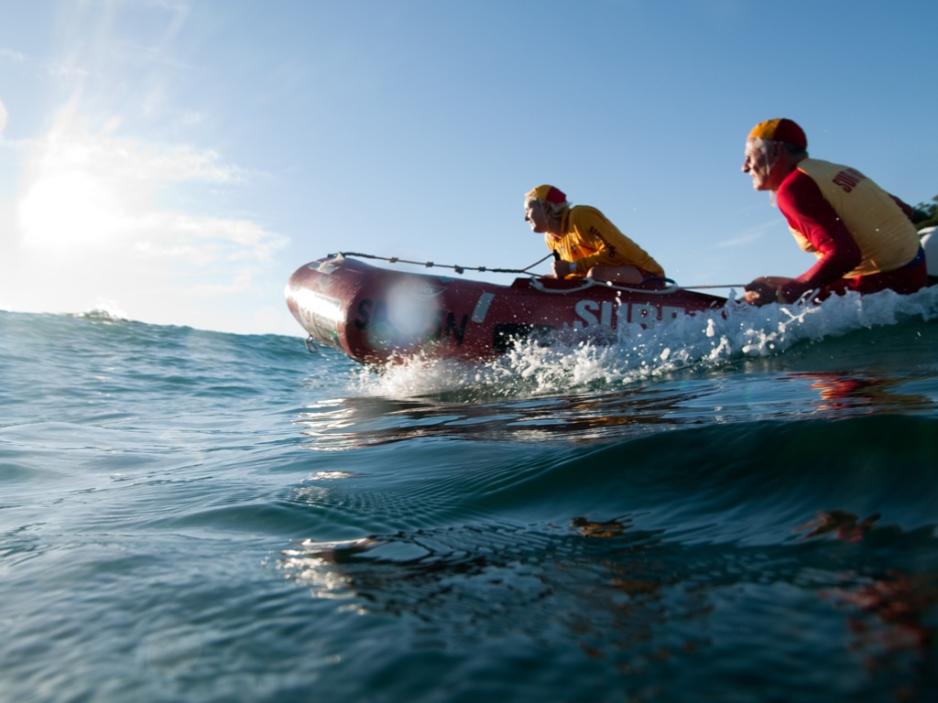
Qualified IRB driver
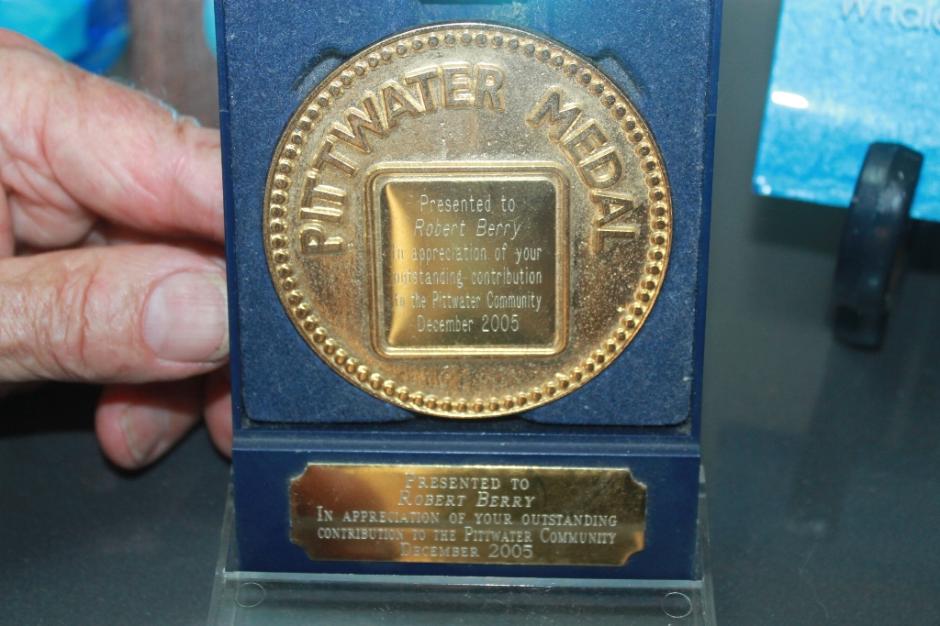
Copyright Robert Berry, 2015.